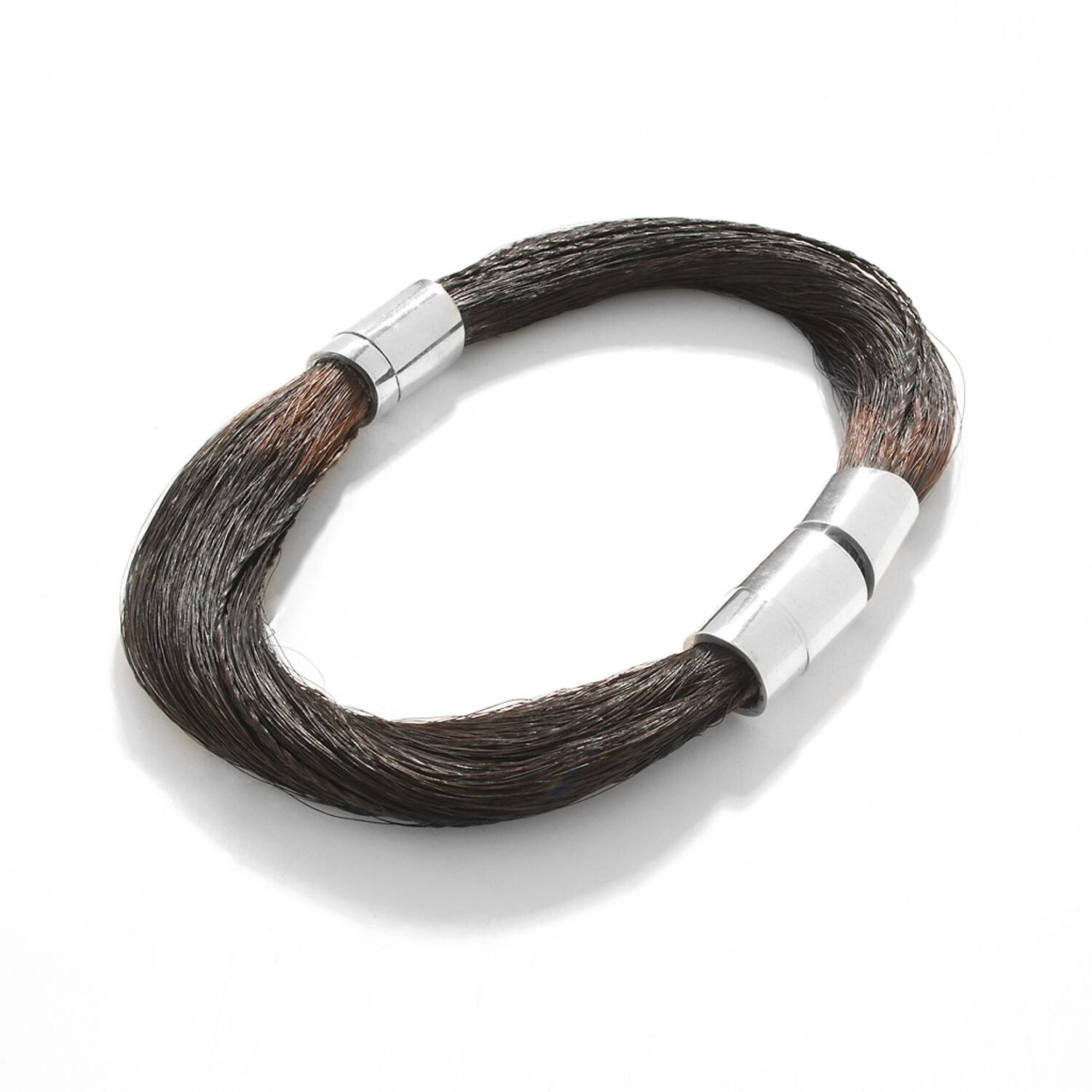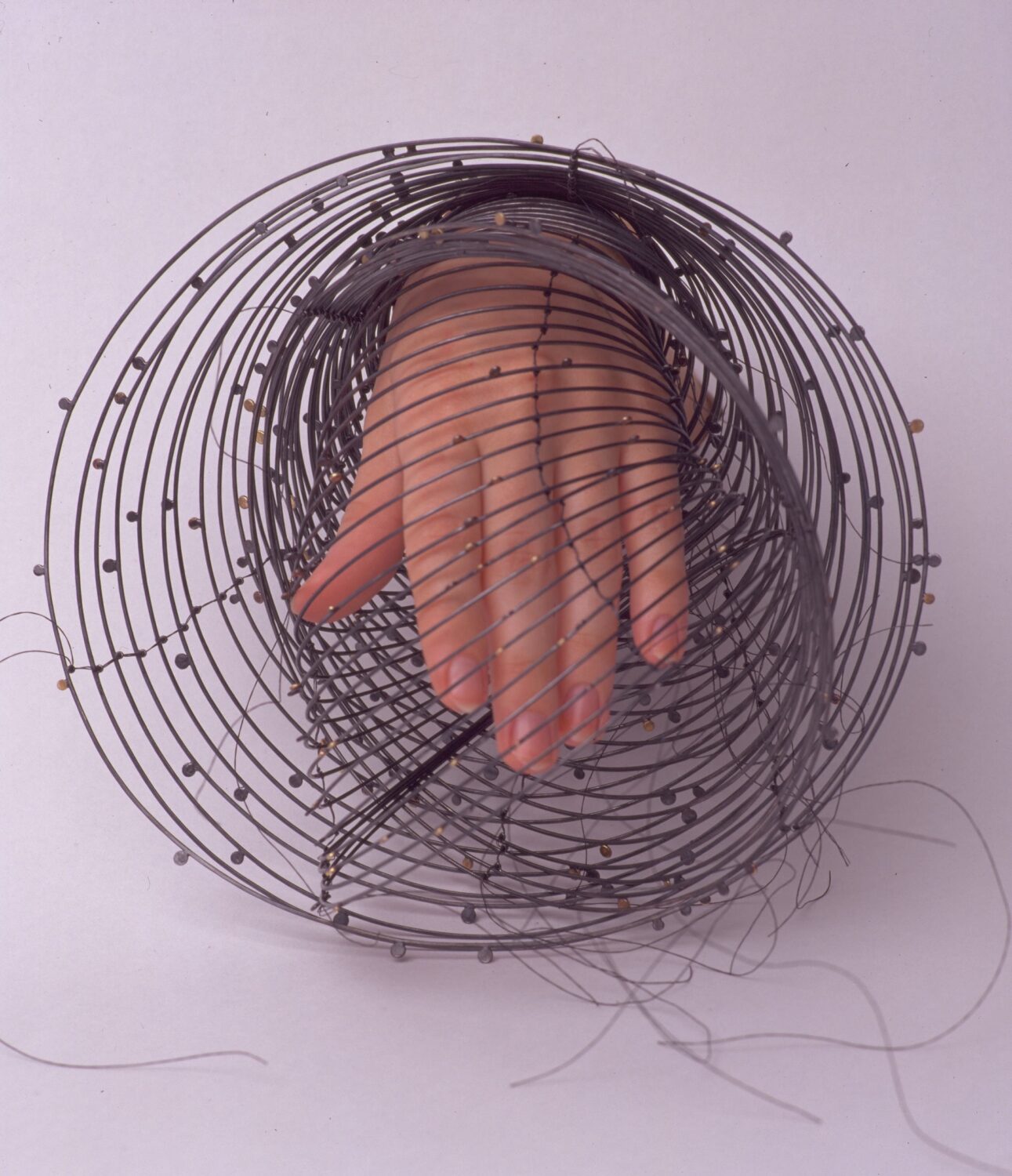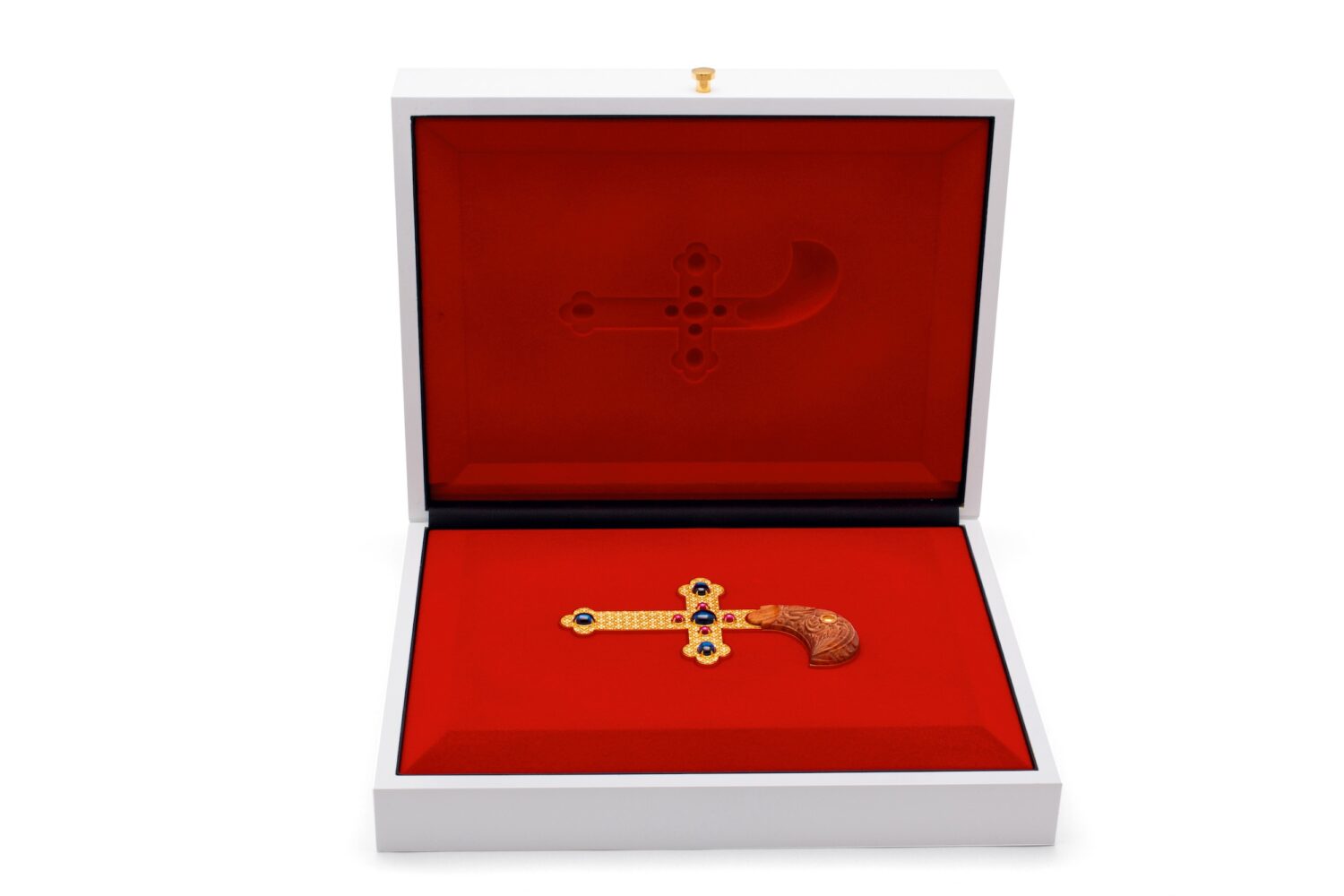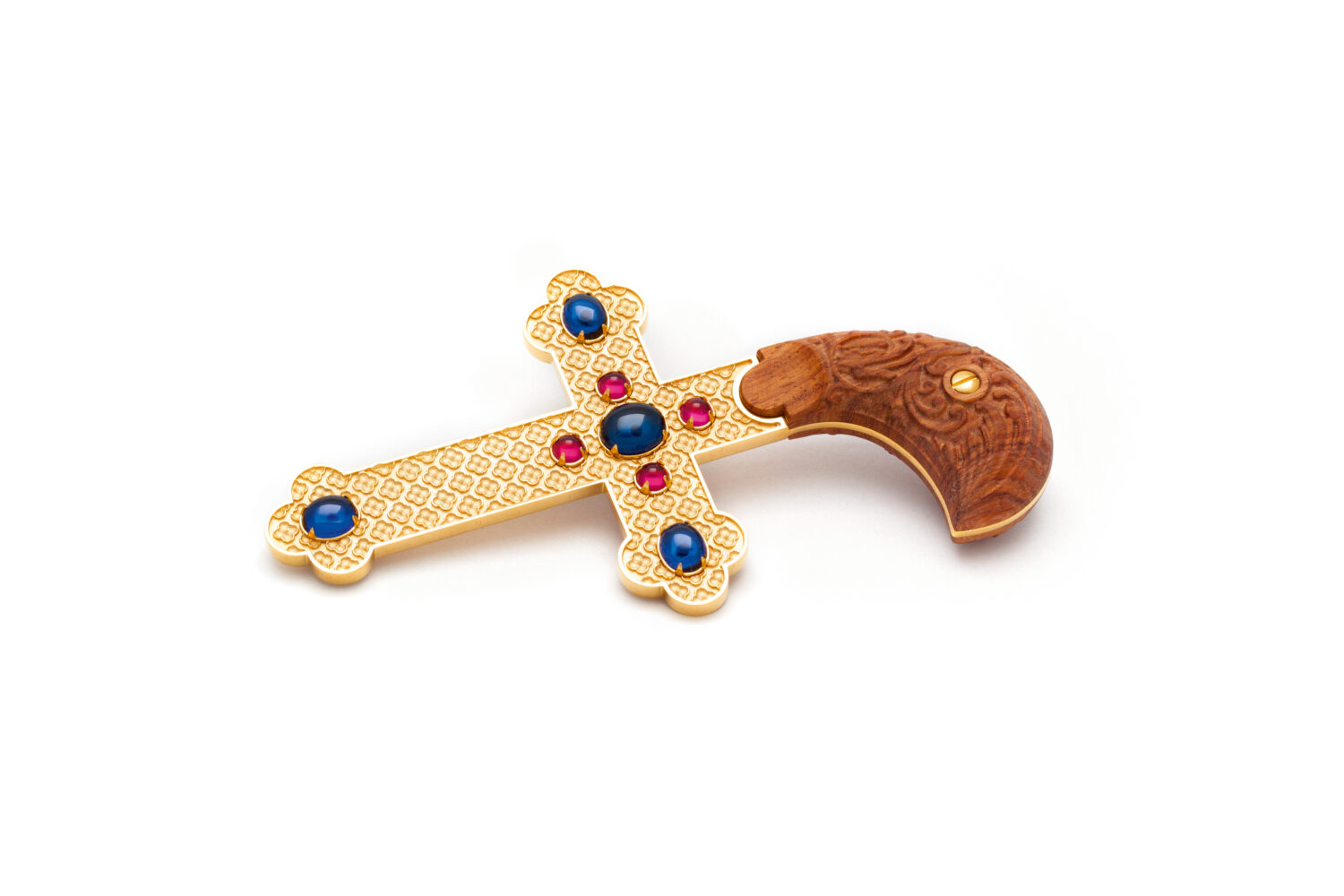As heralded during the 1960s by leading actors in the field – Ole Bent Petersen, Arje Griegst and Helga and Bent Exner – the 1970s became the decade when one-off jewellery regarded as works of art had their definitive breakthrough. The two goldsmiths Jan Lohmann and Peder Musse stood out among the young names, both as internationally oriented jewellery artists and as organizers. Together, they established Galerie Metal in Copenhagen in 1978, which soon gained popularity as an observant and intimate showcase for one-off jewellery with two annual exhibitions featuring names from both Denmark and abroad. From the early 1980s, new Danish jewellery art intensified its international profiling in exhibitions, and in this new departure with postmodernist influences, Danish gold- and silversmiths naturally drew significant inspiration from the global melting pot of jewellery art. At the same time, education at the Danish College of Jewellery and Silversmithing had an almost exclusively artistic slant, and many of its students undertook supplemental studies in the Netherlands or Germany, which, along with Britain and the United States were among the vanguard in this new era of jewellery art. (1)

The hierarchy of materials is dismantled – anything goes
However, drastically rising prices of precious metals during the late 1970s led to a certain moderation. In combination with the deep-felt departure from conventions and the embrace of alternatives to ordinary jewellery conservatism, this further fuelled far-reaching material experimentation that has characterized all aspects of Danish jewellery art since the mid 1970s and the postmodernist surge of the 1980s. Gradually, everything became ‘allowed’. As undogmatically as in other areas of contemporary Danish crafts, gold and silver, pearls and precious stones were combined with technological materials, including PVC, acrylic and the new metal of titanium. Jewellery artists also used copper, steel, aluminium and enamel in new, surprising constellations. From the first half of the 1980s, Jan Lohmann experimented with titanium, niobium and steel alongside precious metals in clear-cut, often jagged postmodernist brooches, multilayered angular constructions with thin, leaflike sheets held together by heavy rivets (ill. 3, 1993). Impactfully, the polyphonic artist Peder Musse abandoned the stationary structure and put his inventive kinetic jewellery into often quavering and slightly jittery motion, thus piquing the curiosity of both wearer person and observer. Goldsmith Kim Buck, to whom jewellery for the pierced earlobe was ‘too simple a task’ – a symbolic one-liner for all avant-gardism in Danish jewellery art – applied brilliant anodized metallic colours to the humble material of aluminium in intricate, but not contrived, abstract geometric solutions, while Anette Kræn and Lisbeth Nordskov incorporated wiry horsehair from ‘fibre art’ (ill. 5, 1995)

Anette Kræn also used brass brush bristles and corset ribs in horn and enamel. Other expressive possibilities were played out in materials such as ivory and wood, ceramic, paper and textile, while Hanne Behrens activated virtually all the textile techniques – knitting, weaving, crocheting and so forth – in her metal wire jewellery. The creative goldsmith Mikala Naur chose ‘Gold and Rubber’ as the name of the workshop boutique she opened in Copenhagen in 1983. Using unpretentious material combinations and revealing her exquisite sense of colour, she created innovative jewellery in the form of figurative ready-mades spanning a wide range of everyday topics, such as keys, fish lures, tea balls and lids from Nescafé tins, as well as sophisticated, purely abstract pieces (ill. 1, 1997). (2)
Positions in one-off jewellery around the beginning of the new millennium
The leading Danish silver- and goldsmiths during the 1990s and around the beginning of the new millennium, many of whom still play an active role today, assumed highly divergent positions. In this diverse field, their opinions of each other’s expressions gave rise to quasi-factions. Ole Bent Petersen and Mikala Naur shared a radical, figurative and playful treatment of ‘found’ everyday items, while Gitte Helle practised actual recycling in her totemistic ‘scrap jewels’ made from mundane objects, such as keyhole covers, nails, rusty cogs and so forth. Nicolai Appel, who took over Galerie Metal in 1999 together with Kennie Falk, Lars Glad and Castello Hansen, focused on urban structures and flows, while Pernille Mouritzen was driven by fascination with cityscapes.
The other main figurative approach of the time tended towards the absolute negation of urban everyday life. The dream-like, narrative jewellery art with mannerist qualities that ‘merman’ Arje Griegst was an early exponent of also had a fantastical and more decorative expression in both Irene Griegst’s elegant jewellery, with tiaras as challenging temptations, and Birte Stenbak’s impactful pieces with clear echoes of art nouveau. (3) With an intense sense of mortality, Torben Hardenberg aimed for suggestive and mythical visions in early expressive figurative pieces, fusing emotional, intellectual and sensuous qualities and incorporating inspiration from princely treasures, astrological alchemy and bizarre reinterpretations of classical ideals (ill. 6, 1983). The pictorial elements in Hardenberg’s mask and insect jewellery and elements from moist zones in the form of amphibians, spermatozoa and so forth are balanced with a strong conceptual approach. (4)
By contrast – and far from the phantasmagorical and narrative realm – a diverse range of abstract constructive and mainly minimalist approaches found a clear expression in Kim Buck’s work, in Eva Dora Lamm’s and Lone Gudmundsson’s geometrically purist jewellery and in Jan Lohmann’s, Claus Bjerring’s and Bess Kristoffersen’s creations. Karen Ihle’s and Jens Eliasen’s dynamic rings, brooches and bracelets had a constructive element as their structural principle: the narrow gap between two parallel surfaces that are simultaneously held apart and joined together by visible axes, like Venetian blind slats (ill. 7, 1994). (5) In the 1980s, Georg Jensen tapped into the potential of the global market with a diverse and innovative jewellery production, some years launching 40 to 60 new jewellery designs. In 1994, Nanna Ditzel, who created jewellery designs for Georg Jensen for five decades, designed the ‘Grates’ series consisting of earrings and a bracelet constructed of grate-like square silver links (ill. 8). Regitze Overgaard and Nina Koppel introduced flexibility and combination in their designs for Georg Jensen. (6)
In between the two figurative and the abstract constructive trends, a wide organic and nature-oriented field expanded, where jewellery with poetic-lyrical qualities took on lively identities at the intersection of abstraction and figuration. Often with associations to somewhat zoomorphic qualities, like Per Suntum’s delicate, organically ‘felt’ creatures (ill. 4), or to floral and insect-like aspects, as in Kirsten Clausager’s pieces. Kasia Gasparski’s evocative homage to growth drew on inspiration from fruit shapes, seed pods, submarine creatures and microscopic cell structures (ill. 2, 1995). In this field, Thorkild Thøgersen was closest to the constructive abstract with his cut, bent and gathered silver threads. With their individual and richly creative perspectives, Agnete Dinesen, Jytte Kløve, Allan Scharff and Anette Kræn, too, operated in this nature-related field, as did Karen Fly, who had a particular emphasis on Greenlandic materials and organic topics. In her treatment of materials and her expressive power, Anette Kræn also had a kinship with the ‘new wild ones’ of 1980s jewellery art, the expressive and conceptual Ulrik Jungersen and Henrik Bløndal Bengtsson. Josephine Bergsøe, too, occupies an expressive position with pieces that possess a raw, insistent dynamic. To all these jewellery artists, the quality of the craftsmanship was vital. (7)

Jewellery that interacts with the living body – body jewellery
There is wonderful jewellery whose practical, functional aspects are subordinate to the role of an autonomous miniature sculpture that may primarily have been intended as an exhibition object, a collector’s item or a potential museum acquisition. In a countermovement to this approach, and not without inspiration from punk, some jewellery artists have sought to ‘reclaim’ the human body by creating jewellery that only comes into character in interaction with the shapes and curves of the living body. In the late 1980s, Lisbeth Nordskov took this to the max with large, unconventional pieces of jewellery for the arm, body and neck made of rubber plates in combination with silver and, later, put together in ribbons made of cut-up black bicycle inner tubes. After his ‘wild’ ritual aggressiveness towards jewellery surfaces, in 1993–95, Ulrik Jungersen highlighted the spatial encounter between object and body in his dizzying, intense ‘Hamlet Machines’ and two stereometric series ‘A-Part’ and ‘Pointing Point’, both featuring cut-through monochrome shapes whose clean cuts and surfaces interact with the body in ways that give rise to illusions. (8)
The exploration of the encounter between jewellery and body was particularly intense during the 1990s, still on a democratic basis, with materials such as silver, mother of pearl, plastic, iron, gold, elastic and silk chiffon treated as equally valid constructive and expressive partners. In spectacular, poetic and conceptual fashion, designers now embarked on inspiring expeditions beyond the realm of mainstream jewellery concepts. This includes Mette Saabye with her foaming bracelet ‘Drops of Dew’ made of small mother-of-pearl slices (1997–98) and her bracelet ‘Body Part’ (ill. 9, 1998); Josephine Winther with her large-scale transparent and spatial plastic necklace ‘Containment’; Nicolette Stoltze with her bracelet and hand piece ‘Tro og lidelse’ [Faith and Suffering] (1999); and Helle Bjerrum with taut lines encircling the body in ‘Hovedlinier’ [Headlines] (1999) and ‘Wings’ (1999).
Body jewellery took on a costume-like feel with a medieval aura in Gitte Bjørn’s 2000 design of a hood, a collier and a helmet made of discontinued low-value Danish coins, rubber bands, silver and two-component pigmented glue. In diametrical contrast to this expression, others set the course for science fiction and cyberspace: Karina Noyons’s head pieces ‘Mindspace’ (1999) and ‘Selvsving’ [Self Circling] (2000), introduced a ‘space’ look that depended on the body’s active engagement, and brooches and large facial jewellery by Anders Leed Christensen with titles such as ‘City Silence’, ‘In-flow’, ‘Hearring’ and ‘Frequencies’ had a device-like techno-character that embraced the brave new digital universe. (9)

Critical statements – meaning-making among the actors
Command of the specific materials is still considered an absolute requirement, and jewellery designers often base their work on material properties and traditional jewellery types. However, in a challenging turn, jewellery design in the current century has also embraced potentiating conceptual and narrative qualities, challenging statements and moral and ethical mementos. The choice of materials in this part of the field is guided more by conceptual content, communication and the thought-provoking and polemic potential in the viewer’s encounter with the jewellery object, whether the message-driven piece is an autonomous exhibition object or is worn by someone. This allows for a meaning-making dialogue among the actors: the jewellery artist, the jewellery as medium, the wearer and the viewer. Critical reflections on identity, everyday life, consumer culture and human and social conditions are prominent aspects, as is the designers’ motivation: the urge to make jewellery relevant by engaging with contemporary conditions.
The recycling of evocative fragments of reality that became known as ‘scrap jewellery’ during the 1980s and which was introduced in Denmark by Kirsten Rose and Gitte Helle has been updated by Mette Laier and by Helen Clara Hemsley’s use of found textile scraps. Similarly, in her project ‘Ordnung lass’ sein’ [Let There Be Order] (2018), Camilla Prasch focused on the discarded, ruined and flawed in assemblage-style pieces. And of all the keys on the keyboard, Mette Laier chose the ‘Esc’ or ‘escape’ key for her set of grey cufflinks (2005) sourced from scrapped computers. (10)
In a time of rampant hostility towards immigrants, some jewellery designers have targeted entrenched Danish nationalism in critical statements. In Katrine Borup’s cryptic series ‘Very Danish’ (2006–07), small red and white candle rings form a Danish flag. The rings reflect cultural norms, and if the ring fits, symbolically speaking, the wearer will have passed the ‘Danishness test’. (11) In a piece with a similarly castigating and humorous tone, Marie-Louise Kristensen has created embroidered orders of chivalry, reminiscent of bellpulls in shape, featuring symbols of Danishness: a pig, the Tivoli Gardens, the Danish flag and a miniature bottle of Rød Aalborg aquavit (ill. 10, 2005). (12)

In ‘Bless You’ (ill. 11, 1912), one of the metal pieces in Kim Buck’s later production that comment on jewellery, the ruby-studded fusion of a cross and a pistol is a statement about abusing religion to define oneself or others as ‘wrong’. (13) In a similar vein, Birgitte Holmsteen exposed neocolonialism and the lack of global responsibility in her project ‘Take what you want’, created for the Danish Biennale for Craft & Design in 2013. At the Biennale, 200 brooches, which formed a world map, were gifted to exhibition guests who, in return, committed to continuing the dialogue about global responsibility. (14) In jewellery projects such as ‘32 Million Years After Homo Sapiens (ahs)’ (2017), made from gold, amber and different types of plastic, Anette Dam questions consumer culture and the ‘treasures’ we leave behind for a potential future civilization.
The eternal inspiration from nature
As an antipole to critical and politicizing jewellery, other gold- and silversmiths have revitalized jewellery history’s eternal inspiration from nature. Equally fascinated by nature’s shapes and phenomena as by the fabulous creatures conjured up by human minds, these jewellers create figurative pieces within all the categories, including pure objects of art, using the traditional precious materials of the trade. (15) The creatures represented by this pictorial jewellery have a symbolic history, but from a global and cross-cultural perspective, a contemporary observer will not perceive them as possessing fixed or unambiguous meanings, as they have featured in a wide range of cultures and associated with varying values. For example, in early Christian culture, the peacock symbolized divinity and God’s all-seeing eye, but during both antiquity and the Middle Ages, it was associated with negative qualities, such as arrogance, vanity and the sin of pride. Gold- and silversmiths have found their topics in the watery element, in lush forests or in the air, home to winged transitoriness, and among creatures ranging from giant prehistoric lizards to chameleons, dragon flies and the transparent firefly. There is an obvious connection here to art nouveau with its close-up Japanese images and its ornamental world of subjectively interpreted insects, snakes and interesting birds.
In his organic, abstract opening silver brooch ‘Hidden’ (2017), Joakim Hjort highlights the scarab’s rigid exoskeleton and its underlying hidden wings. In silver, gold and light brown diamonds, Fie Bodenhoff created the bracelet ‘Tusindben’ [Millipede] (2019) from 360 textile eye fasteners, and Tina Gjersen-Sav’s series featuring 101 insects is a confusing and disturbing world in silver and gold, red spherical garnet eyes and green, blue and violet sapphires. In the vigorous jewellery set ‘Octopus Temple’ (2019), Orit Elhanati used gold and opals to create a fantasy on the octopus’s monstrous arms and suckers, while the whale, the Norwegian Sea, the Arctic and the tundra provided mental and physical raw materials for Christine Bukkehave’s expressive and sophisticated pieces. Allan Scharff’s ‘Free Birds’ in silver hollowware have a similar aerodynamic interpretation, stylized to jewellery form, and in a ring and a brooch (2019), the crane performs its own graceful ballet, choreographed by Ole Lynggaard. (16)
In recent years, mythological material has also served as a compelling projection space and a rich reservoir of potential themes and statements on human nature. The Harpy eagle, a mythological creature from antiquity, inspired Hanna Beate Maria Wiklendt-Jensen’s Baltic amber project ‘Vanity Dilemma’ (2019), while Claus Bjerring’s brooch ‘Gennembrud’ [Breakthrough] (2019) addresses the origins of the myth about the virile unicorn and hints at the story’s continuing life in the spiral of time. Shaped as a skeleton, fixated in mid-wing stroke, even poetry’s immortal fabulous animal, the white stallion Pegasus, has been caught up by time in Ninna York’s object of art ‘Tempus Fugit’ [Time Flies] – much too tall and heavy to wear, it rises above the standard typological categories of jewellery art (ill. 12, 2018-19). (17)
Green gold – sustainable transition in jewellery production
Collecting production waste and reusing precious metals are traditional virtues of the goldsmith’s trade, and all serious jewellery makers, from individual goldsmiths or jewellery designers in their solo studios to the jewellery giant Pandora, will be aware of the expanded and demanding agenda of the green transition. The motivation to engage with this agenda is also driven by customers’ expectations. Fairtrade silver and gold, typically from Peru, is certified to a degree that makes it possible to trace every single piece of the precious, sustainably traded metals to the specific mine where it was extracted under well-regulated safety conditions, without the use of child labour, and processed without the use of toxic mercury. The price per gram is higher, and when the finished jewellery is sold, the mining town receives a bonus. If oil is ‘black gold, sustainability’s ‘green’ precious metals are certified gold, silver and platinum, which can be infinitely reused and cleaned and thus have the long-term potential to eliminate the need for mining. Similarly, the use of synthetic, lab-made diamonds and other gemstones produced above ground using green energy has led to a radical reduction of the carbon footprint compared to mining (18). In this way, the ‘precious’ processes of jewellery production and a similarly critical look at other, more unorthodox jewellery materials make a real contribution with sustainable platforms for a non-dystopian future.
Facts
The article is an excerpt from a larger article for the upcoming publication “Danish Design History 1+2” edited by Lars Dybdahl. Volume 1 is written by Lars Dybdahl, and Volume 2 contains texts by about 27 design authors.
It is published by Strandberg Publishing on November 21, 2023.
The price for the two volumes is 599.95 DKK.
The two volumes combined have 904 pages and over 1,100 illustrations
Notes
1/ About the international turn of jewellery art after 1960, see Dormer & Turner (1985/1994).
2/ Descriptions of Jan Lohmann, Peder Musse, Kim Buck and Anette Kræn in Dybdahl (1995, pp. 61–63, 55–57, 64–66, 37–39). About Lisbeth Nordskov, see Funder (2001, pp. 159–161).
3/ About Arje Griegst, see Wickman (2013). Description of Irene Griegst in Dybdahl (1995, pp. 46–48). About Birte Stenbak, see Funder (2001, pp. 146–149).
4/ About Torben Hardenberg, see Scavenius (2006) and description in Dybdahl (1995, pp. 49–51).
5/ See also descriptions of Eva Dora Lamm and Karen Ihle & Jens Eliasen in Dybdahl (1995, pp. 25–27, 31–33) and descriptions of Claus Bjerring and Bess Kristoffersen in Funder (2001, pp. 120–123, 124 f.)
6/ See Thulstrup (2004, pp. 165–75).
7/ Sea also descriptions of Per Suntum, Kasia Gasparski, Thorkild Thøgersen, Anette Kræn and Ulrik Jungersen in Dybdahl (1995, pp. 43–45, 52–54, 40–42, 37–39, 28–30). About Agnete Dinesen and Jytte Kløve, see Funder (2001, pp. 184–186, 94–96).
8/ See also the descriptions of Ulrik Jungersen in Dybdahl (1995, pp. 28–30) and Funder (2001, pp. 192–196).
9/ The jewellery designers mentioned in this section are described in Funder (2001, pp. 196–201, 204 f., 84 f., 212–215).
10/ About Mette Laier, see Bruun (2016, pp. 260 f.).
11/ About Katrine Borup, see Lenskjold & Lykke Jensen (2016, pp. 280 f.).
12/ About Marie Louise Kristensen, see Bruun (2016, pp. 260 f.) and Lenskjold & Lykke Jensen (2016, pp. 280).
13/ Kim Buck on his meta jewellery, see Rosenlund (2016, pp. 286–87).
14/ About Birgitte Holmsteen, see Lenskjold & Lykke Jensen (2016, pp. 280).
15/ Nature-inspired jewellery designers were selected for the 2019 exhibition Naturens juveler – Jewels of Nature at Naturama in Svendborg. See also Hald (2019).
16/ The jewellery designers mentioned in this section are presented in Hald (2019, pp. 30–31, 26–27, 90–91, 58–59, 66–67, 70–71, 74–75).
17/ The jewellery designers mentioned in this section are presented in Hald (2019, pp. 96–97, 64–65, 98–99).
18/ About the green transition in the jewellery trade, see Pedersen (2022).
References
Bruun, M. B. (2016). Narrativitet og konceptualitet i kunsthåndværket. In L. Dybdahl (Ed.) Dansk design nu (Danish design now) (pp. 260–271). Strandberg Publishing.
Dormer, P. & Turner, R. (1994). The New Jewelry: Trends + traditions. Thames and Hudson.
Dybdahl, L. (1995a): Dansk smykkekunst: 20. århundrede / Danish jewellery: The 20th century. In J. Lohmann & L. Funder (Eds.) Nordisk smykkekunst / Nordic jewellery (pp. 9–21). Nyt Nordisk Forlag Arnold Busck.
Dybdahl, L. (1995b): Eva Dora Lamm, Ulrik Jungersen, Karen Ihle & Jens Eliasen, Kirsten Clausager, Anette Kræn, Thorkild Thøgersen, Per Suntum, Irene Griegst, Torben Hardenberg, Kasia Gasparski, Peder Musse, Jan Lohmann, Kim Buch. In J. Lohmann & L. Funder (Eds.) Nordisk smykkekunst / Nordic Jewellery (pp. 25–66). Nyt Nordisk Forlag Arnold Busck.
Dybdahl, L. (Ed.) (2016). Dansk design nu (Danish design now). Strandberg Publishing.
Funder, L. (2001): Dansk smykkekunst / The art of Danish jewellery 1960-2000. Nyt Nordisk Forlag Arnold Busck.
Hald, N. (2019): Jewels of nature. Naturama.
Lenskjold, T. U. & Jensen, J. L. (2016). Statement design og konceptuelle greb. In L. Dybdahl (Ed.) Dansk design nu (Danish design now) (pp. 274–285). Strandberg Publishing.
Lohmann, J. & Funder, L. (Eds.) (1995). Nordisk smykkekunst / Nordic jewellery. Nyt Nordisk Forlag Arnold Busck.
Pedersen, N. (2022, 20 May). Hos guldsmeden genbruger man det gamle guld. Politiken (Design Section, pp. 4–6).
Rosenlund, C. (2016): Kim Buck: Metasmykker der kommenterer smykker. In L. Dybdahl (Ed.) (2016), Dansk design nu (Danish design now) (pp. 286–287). Strandberg Publishing.
Thulstrup, T. C. (2004). Georg Jensen: Sølv & design (Georg Jensen: Silver and design). Gads Forlag.
Note to this excerpt:
Not all illustrations mentioned in the text are included in this version. Instead, please refer to the print edition for a complete overview of photographs.


